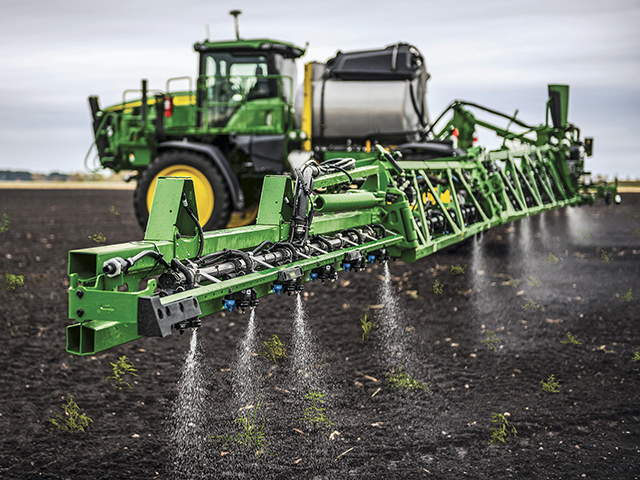Weed Control Beyond the Jug

Multiple herbicide-resistant waterhemp infestation in a soybean field in Renville County, MN. The field was treated with one pre and two-pass post during the season.
Multiple herbicide-resistant waterhemp infestation in a soybean field in Renville County, MN. The field was treated with one pre and two-pass post during the season.
Weed control has come full circle now that the glyphosate “easy button” no longer automatically works. The challenge is implementing the right cultural tools with herbicides to ensure current chemistry remains a viable option longer.
“If you look back in agriculture, farmers used to deploy multiple levels of complex tactics to take care of weed problems—from plowing and ripping to cultivation, rotary hoeing, hand weeding, fallow and animal grazing,” says Seth Naeve, Extension agronomist and professor, Agronomy & Plant Genetics, University of Minnesota.
With herbicide tolerance in weeds firmly entrenched in many species, the goal now is to decrease the number of weed seeds that survive every year. That starts by reducing the weed seedbank.
University of Minnesota Extension weed scientist Debalin Sarangi says targeting the soil’s weed seedbank takes a systems approach.
In a corn-soybean rotation, think about control tactics for the next three to four crops. If you’re better at managing weeds in corn than soybeans, don’t assume the good and bad years of weed control average out to improve the weed seedbank.
“Weed seedbanks are very persistent and are difficult to deplete quickly,” Sarangi says. “Your toughest, most prolific seed-producing weeds (waterhemp, Palmer amaranth, marestail, ragweed, kochia) that resist multiple herbicide groups can take four years of excellent control to remove one year of bad control from the seedbank.”
Tactics like tillage, narrow rows and cover crops are nothing new within integrated weed management. All have unique aspects that can affect weed control depending on a farmer’s practices and mindset.
With his research and educational background, Sarangi knows tillage advantages and disadvantages, coming from broad no-till use in Nebraska to heavy tillage use in Minnesota. “No-till has a lot of good conservation and soil health benefits. But depending on the seedbank size and composition, no-till has weed management challenges due to weed seeds being on top of the soil or residue — and relying on herbicides without [the benefit of] tillage,” he says.
“However, a few years of aggressive weed management in no-till can deplete the seedbank more quickly than a conventional tillage system,” he adds.
Heavy tillage may bury this growing season’s weed seed, but it brings buried seed back to the surface, too. Depending on the weeds present, using tillage once every four years helps to deplete the weed seedbank.
Narrow row spacing in soybeans will close the canopy sooner, helping to reduce weed pressure. But is it for everyone? Naeve says several factors should be considered. “Planter costs, yield differences, seed populations, weed pressure — all must be examined for risk versus benefit,” he says.
Sarangi completed a two-year research study to see if narrow-row soybeans helped waterhemp control in a sugar beet-soybean rotation. Narrow rows (12 or 15 inches versus 22 inches) closed the canopy seven to 14 days earlier than the wider row spacing. It provided weed control benefits in a low-input herbicide program (single-pass postemergence application) but showed no benefit under an aggressive three-application (one preemergence and two postemergence) herbicide program. Weed control was mostly driven by the herbicides in this scenario.
“We cannot skip the preemergence herbicide application to reduce the weed seedbank,” Sarangi says. “This application will help growers start clean and buy time and flexibility to time your post applications.”
Farmers are proving that the right cover crop tactics that grow high biomass cereal rye can suppress weeds. In a two-year study (2022-2023), Sarangi compared weed suppression in soybeans by terminating cereal rye before planting in late April-early May versus green planting and then terminating seven days after planting.
Early termination provided little to no weed control benefit — late termination a week after planting provided higher biomass that did suppress weeds. “We had cereal rye stand establishment challenges due to fall drought when we seeded after corn and soybean harvest in Minnesota. So, if farmers plant cash crops before early May, a cereal rye cover crop won’t offer much weed suppression value in most cases due to less biomass accumulation,” Sarangi says.

John Deere See & Spray technology
New technologies used to spot spray weeds automatically using cameras, software and artificial intelligence (AI) add value to reduce the weed seedbank.
Sarangi views this see and spray technology as a way farmers can reduce herbicide use in fields, but it won’t eliminate the need for a preemergence pass. “The technology is good, but it will take time to determine if it is economically viable depending on farm size.”

Redekop’s Seed Control Unit (aka hammer mill) is attached to a farmer’s combine near Glencoe, MN. This site is part of a multi-state testing project for this unit in the US. The research is led by the GROW IWM group, and Sarangi, Naeve, and Nicolai (Extension Educator) at the University of Minnesota are testing it on MN farms.
A second new technology changes the combine from a weed seed spreader to a weed seed predator. Researchers from Australia and the U.S. showed that seed terminator Australian technology using a cage or hammer mill can pulverize weed seeds. “It can pulverize 95 to 99% of waterhemp and Palmer amaranth weed seeds,” Sarangi says.
“These two systems offer some exciting technologies coming to market that add more tools beyond herbicides to deplete the weed seedbank,” he says.
But Mother Mature won’t give in easily. “We just need to remember that pigweeds, for example, can add 500,000 seeds per plant into the seedbank,” reminds Sarangi.
Content provided by DTN/Progressive Farmer
Find expert insights on agronomics, crop protection, farm operations and more.